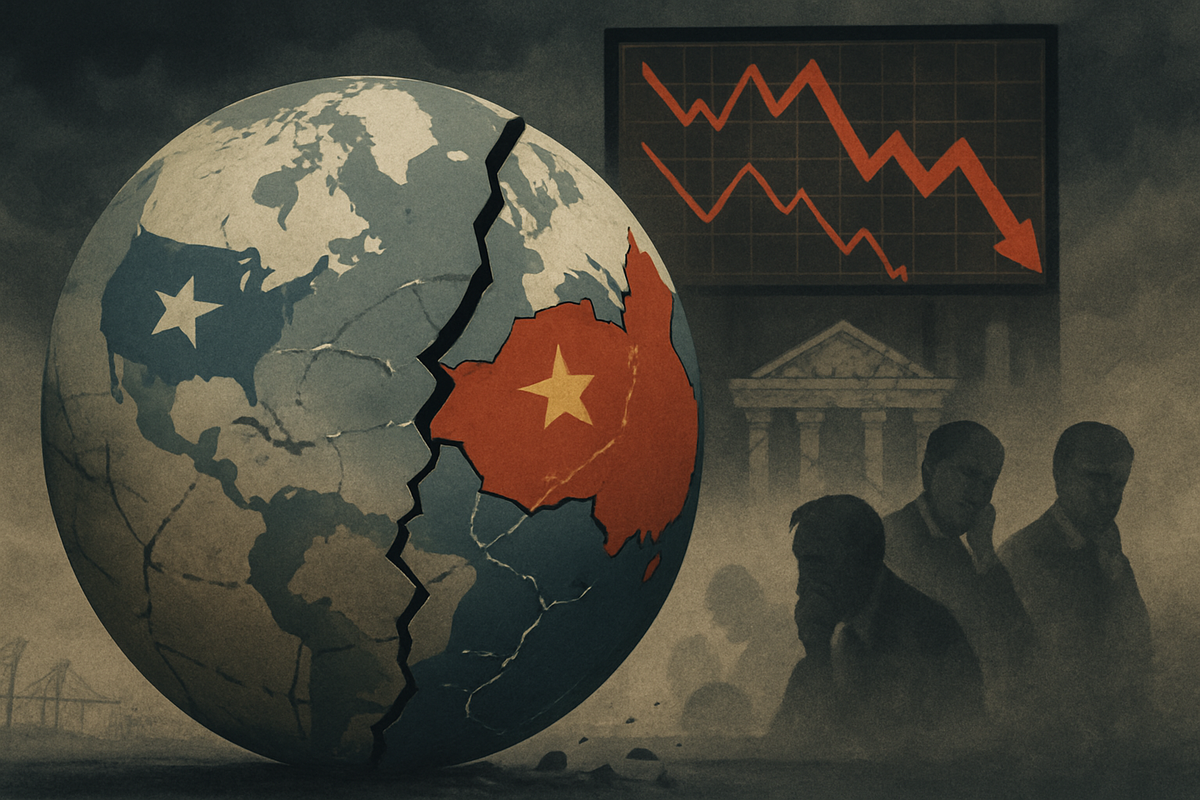
As of October 17, 2025, U.S. financial markets are gripped by a palpable sense of unease, with the Dow Jones Industrial Average, S&P 500, and Nasdaq Composite experiencing mixed and volatile trading. This market turbulence is primarily fueled by a potent cocktail of re-escalated U.S.-China trade tensions, stemming from recent aggressive rhetoric from former President Donald Trump, and a fresh wave of anxiety surrounding the quality of bank loan portfolios, particularly within the regional banking sector. The convergence of these two significant headwinds has injected considerable uncertainty into investor sentiment, prompting a cautious retreat from riskier assets and a scramble towards safe havens.
Geopolitical Tensions and Credit Contagion Send Shivers Through Wall Street
The current market jitters are a direct consequence of a dual assault on investor confidence: the specter of an intensifying U.S.-China trade war and the unsettling emergence of credit quality issues within the banking sector. The trade dispute, a carryover from the previous Trump administration, has seen a renewed surge in aggressive rhetoric and policy threats in recent weeks, significantly impacting global supply chains and corporate outlooks.
On October 10, 2025, former President Donald Trump reignited trade war fears with threats of an additional 100% tariff on Chinese imports, layered atop existing duties, and proposals for new export controls on critical U.S.-made software. This move, following China's tightened restrictions on rare earth exports, immediately sent U.S. equities tumbling, with the S&P 500 experiencing its largest one-day decline since April, dropping approximately 3%. The market further reacted on October 14 when Trump, via a Truth Social post, suggested "terminating business" with China over soybeans and cooking oil, accusing Beijing of economic hostility. This specific comment led to a 0.2% decline for the S&P 500 and a 0.8% fall for the Nasdaq Composite, although the Dow managed a slight 0.4% gain, indicating a fragmented market response. While occasional softening of rhetoric, such as Trump's "Don't worry about China, it will all be fine!" post on October 12, offered brief market rebounds, the underlying volatility remains high. The ongoing U.S.-China economic relationship is now characterized by aggressive tariff regimes, with average U.S. tariffs on Chinese goods at approximately 57.6% and China's retaliatory tariffs around 32.6%, pushing towards a significant economic decoupling. Key players include the U.S. and Chinese governments, multinational corporations reliant on global supply chains, and consumers facing potential price increases.
Simultaneously, the financial sector is grappling with escalating concerns over bad bank loans. On October 16, regional bank stocks suffered a significant sell-off following alarming disclosures. Zions Bancorporation (NASDAQ: ZION) reported a $50 million charge-off related to two commercial and industrial loans due to "apparent misrepresentations and contractual defaults," causing its shares to plummet 13.1%. Concurrently, Western Alliance Bancorporation (NYSE: WAL) saw its shares drop over 10% after revealing a lawsuit against a fraudulent borrower and exposure to the collapse of auto parts maker First Brands Group. These revelations triggered a broader market reaction on October 16, with the Dow sliding 0.7%, the S&P 500 declining 0.6%, and the Nasdaq falling 0.5%. The credit stress intensified on October 17, with U.S. stock futures continuing their descent, further highlighting concerns about overall U.S. credit quality. This fear has led to a noticeable flight to safety, with gold prices surging to new record highs above $4,300 per ounce and 10-year Treasury yields falling below 4% for the first time since early April. The underlying concerns are particularly focused on commercial real estate (CRE) loans, where regional banks hold a disproportionate 44% of their portfolios, and subprime auto loans, exacerbated by recent bankruptcies like that of subprime auto lender Tricolor Holdings. JPMorgan CEO Jamie Dimon's stark warning that "when you see one cockroach, there are probably more" encapsulates the pervasive anxiety within the financial community.
Winners and Losers: Corporate Fortunes in a Turbulent Market
The twin pressures of an escalating U.S.-China trade war and mounting concerns over bad bank loans are creating a distinct bifurcation in corporate fortunes, yielding both clear winners and significant losers across various sectors. The ripple effects are profound, influencing supply chain strategies, investment decisions, and ultimately, profitability.
Technology and Manufacturing Giants Face Headwinds: Companies deeply embedded in global supply chains, particularly those reliant on both U.S. and Chinese markets, are feeling the brunt of the trade war. U.S. export controls targeting China's semiconductor industry, coupled with China's retaliatory restrictions on rare earth minerals, directly impact tech giants. Companies like Nvidia (NASDAQ: NVDA) and Intel (NASDAQ: INTC) have seen their stock prices decline amidst worries over shifting trade policies, as tariffs could compress margins for high-end smartphones by up to 10% and lift costs for AI server chips by 10-12%. Similarly, consumer electronics and automotive manufacturers, including Apple (NASDAQ: AAPL) and Tesla (NASDAQ: TSLA), heavily dependent on Chinese manufacturing and rare earth components, face increased costs and supply chain disruptions. Apple, for instance, has accelerated efforts to diversify its manufacturing to India and Vietnam, investing over $1 billion in Indian facilities, yet still grapples with bottlenecks and increased lead times. U.S. renewable energy firms, reliant on Chinese solar and wind components, also face rising costs and project delays.
Regional Banks Bear the Brunt of Credit Concerns: The recent revelations regarding bad bank loans have cast a long shadow over the U.S. regional banking sector. These institutions, with their disproportionate exposure to commercial real estate (CRE) loans—holding about 44% of their portfolios—are particularly vulnerable. Zions Bancorporation (NASDAQ: ZION) saw its shares plummet by 13.1% after disclosing a $50 million charge-off due to fraud in commercial and industrial loans. Western Alliance Bancorporation (NYSE: WAL) also experienced an 11% stock drop following a lawsuit against a fraudulent borrower. These incidents, alongside the bankruptcies of auto parts supplier First Brands Group and subprime auto lender Tricolor Holdings, have led to significant losses for their lenders. JPMorgan Chase (NYSE: JPM), despite its size, reported a $170 million loss from soured loans to Tricolor, highlighting that even major players are not immune. Other regional banks like Fifth Third Bancorp (NASDAQ: FITB) and Regions Financial (NYSE: RF) have also experienced declines as investors pull back, fearing widespread credit deterioration.
Emerging Opportunities for Select Industries: While many suffer, certain sectors are poised to benefit. Non-Chinese rare earth mining and processing companies, such as MP Materials (NYSE: MP) and Critical Metals (ASX: CRML), are experiencing a surge in demand and investment as nations seek to secure alternative supply chains away from China. This strategic pivot is driven by government incentives and a push for domestic resource independence. Furthermore, Chinese domestic technology and consumer discretionary companies, including Alibaba Group Holding Limited (NYSE: BABA), Baidu Inc. (NASDAQ: BIDU), JD.com Inc. (NASDAQ: JD), and PDD Holdings Inc. (NASDAQ: PDD), could see increased market share if U.S. tech exports to China are curtailed and Chinese consumers favor local brands. Manufacturing hubs in Southeast Asia, India, and Mexico are also attracting significant investment as multinational corporations adopt a "China+1" strategy, diversifying production away from China to mitigate tariff risks and supply chain vulnerabilities. Finally, in times of market anxiety, traditional safe-haven assets like gold and silver thrive. Mining companies in these precious metals, and associated ETFs like the Amplify Junior Silver Miners ETF (NYSEARCA: SILJ) and Sprott Junior Gold Miners ETF (NYSEARCA: SGDJ), are seeing gains as investors flock to perceived stability.
A Shifting Global Landscape: Decoupling, Credit Crunch, and Regulatory Scrutiny
The current market turbulence is more than a fleeting reaction; it signifies a deeper recalibration of global economic structures and financial stability. The U.S.-China trade war and the emerging concerns over bad bank loans are not isolated events but rather interconnected forces driving profound industry trends, creating extensive ripple effects, and prompting significant regulatory and policy shifts, all against a backdrop of historical precedents.
The Era of Decoupling and Supply Chain Reshaping: The U.S.-China trade war, intensified by recent tariff threats and export controls, is accelerating a trend towards economic decoupling, where national security and supply chain resilience are increasingly prioritized over pure economic efficiency. This is leading to a significant reconfiguration of global supply chains, with multinational corporations adopting "China+1" strategies—diversifying production to countries like Vietnam, India, and Mexico—and exploring reshoring options. While this diversification aims to mitigate risks, it introduces new logistical complexities, higher capital expenditures, and increased operating costs, ultimately contributing to inflationary pressures across various sectors, including electronics, automotive, and pharmaceuticals. The World Trade Organization (WTO) warns of significant global GDP losses if the world fragments into trading blocs, underscoring the long-term economic risks of this shift. Technology restrictions, particularly on semiconductors and rare earth elements, further threaten to stifle innovation and create fragmented technological ecosystems.
Financial Contagion and the Looming Credit Crunch: The concerns over bad bank loans, especially within the U.S. regional banking sector, highlight a broader fragility in the financial system. Historically, periods of rapid credit growth and lenient lending precede large volumes of non-performing loans (NPLs). The current situation, with delinquency rates for U.S. office loans nearing 2008 peaks and over $1 trillion in commercial real estate (CRE) loans maturing by the end of 2025, mirrors past crises like the Savings and Loan Crisis. A surge in NPLs directly erodes bank profitability, restricts lending, and can trigger a "credit crunch," hindering economic growth. This financial stress has already caused global stock markets to fall, with European and Asian banking sectors also experiencing losses, demonstrating the potential for global financial contagion. The increased risk aversion among banks means tighter credit standards, impacting businesses across all sectors that rely on financing for operations and expansion.
Regulatory Scrutiny and Policy Shifts: Both governments are responding with significant policy adjustments. The U.S. has implemented new 100% tariffs on Chinese imports, effective November 1, and China has responded with reciprocal measures, further escalating the trade conflict. These actions are driven by a focus on national security and self-sufficiency, exemplified by initiatives like the U.S. CHIPS and Science Act. On the financial front, regulators are intensifying surveillance and early intervention efforts to prevent NPL formation. The ongoing implementation of tougher Basel III requirements and the Federal Reserve's 2025 stress tests are crucial for assessing bank resilience, particularly against severe declines in CRE values. There is also increased scrutiny on lending practices, especially to non-bank financial institutions, and a broader push for public feedback on combating fraud. These regulatory shifts aim to bolster the financial system but may also lead to more conservative lending practices and potentially slower economic growth.
Historical Echoes and Interconnected Risks: The current confluence of trade protectionism and financial instability carries echoes of historical periods of economic turbulence. Past trade wars, such as the Smoot-Hawley Tariff Act of 1930, are widely believed to have exacerbated the Great Depression. Similarly, banking crises, from the Panics of the 19th century to the Global Financial Crisis of 2008, have consistently led to significant and persistent declines in economic output and rises in unemployment. The critical takeaway from history is that these two forces are often intertwined, with economic headwinds from trade disputes making it harder for businesses to repay loans, thereby exacerbating banking sector vulnerabilities. This "nasty little cocktail" of risks underscores the need for careful navigation by policymakers and businesses to avoid a prolonged period of global economic stagnation.
Navigating the Storm: Future Scenarios and Strategic Imperatives
The convergence of an escalating U.S.-China trade war and deepening concerns over bank loan quality presents a complex and uncertain outlook for global markets. The coming months and years will demand strategic pivots from businesses and vigilant oversight from policymakers to navigate potential pitfalls and capitalize on emerging opportunities.
Short-Term Volatility and Geopolitical Tensions: In the immediate future, through late 2025 and early 2026, markets should brace for continued high volatility. The U.S.-China trade war is likely to remain a dominant theme, with the recently announced 100% tariffs on Chinese imports (effective November 1) and China's retaliatory export controls on rare earth elements (effective December 1) ensuring ongoing disruptions. While a tentative meeting between Presidents Trump and Xi Jinping around the APEC summit offers a glimmer of hope for de-escalation, past truces have proven fragile. Businesses will face increased operational costs, supply chain bottlenecks, and eroded consumer confidence. The banking sector will continue to grapple with loan quality concerns, particularly in commercial real estate, as maturing loans and elevated interest rates put pressure on borrowers. Regional banks will remain under intense scrutiny, with further charge-offs and provisions for credit losses a distinct possibility.
Long-Term Decoupling and Economic Realignments: The long-term trajectory points towards an accelerated economic decoupling, potentially fragmenting the global economy into distinct trading blocs. The World Trade Organization (WTO) forecasts significant global GDP losses in such a scenario, emphasizing the profound and lasting impact. Strategic competition, especially in critical technologies, will continue to define U.S.-China relations. For businesses, this necessitates a fundamental shift in strategy. The "China+1" approach, diversifying manufacturing to countries like Vietnam, India, and Mexico, will become standard practice. Companies will also need to adopt "just-in-case" inventory models, prioritize supply chain resilience, and explore new export markets beyond the traditional U.S.-China axis. Governments, too, will continue to prioritize national security and self-sufficiency, driving investment in domestic industries like semiconductors and pharmaceuticals.
Emerging Opportunities and Persistent Challenges: Despite the headwinds, opportunities will emerge. Companies offering alternatives to Chinese manufacturing, or those involved in domestic infrastructure and advanced manufacturing within the U.S., could see growth. Non-Chinese rare earth producers, like MP Materials (NYSE: MP), will benefit from the push for diversified supply chains. In China, domestic technology and consumer brands may gain market share if trade tensions persist. For investors, safe-haven assets like gold, which has already hit record highs, will likely remain attractive during periods of heightened uncertainty. However, the overarching challenges include persistent inflationary pressures, reduced corporate profitability due to tariffs and disrupted supply chains, and a potential credit crunch as banks tighten lending standards. The shipping industry, already experiencing volatility, will continue to navigate rising costs and geopolitical risks.
Potential Scenarios and Outcomes: One plausible scenario involves a gradual stabilization, where government interventions—including targeted capital injections and policy rate cuts—help to address banking sector vulnerabilities and stabilize the property market, particularly in China. This would lead to a slow, uneven recovery, but with lingering risks. A more pessimistic outcome could see a widespread financial fragility, especially if China's real estate sector experiences a systemic collapse, potentially triggering global credit market contagion. The interplay between trade tensions and financial stress is critical: an economic slowdown caused by trade disputes could exacerbate loan defaults, while a banking crisis could further dampen economic activity, creating a feedback loop of instability. Investors should closely monitor policy developments from both the U.S. and Chinese governments, particularly around trade negotiations and banking sector reforms, as these will be crucial determinants of market direction and stability.
Navigating a New Era: Resilience and Vigilance for Investors
The current market environment, characterized by the renewed intensity of the U.S.-China trade war and the unsettling emergence of bad loan concerns within the banking sector, represents a pivotal moment for global finance. These intertwined challenges are not merely transient jitters but rather harbingers of a new era demanding heightened resilience and strategic vigilance from investors.
Key Takeaways: The immediate takeaway is the acceleration of economic decoupling between the U.S. and China, driven by aggressive tariff policies and reciprocal export controls. This is rapidly reshaping global supply chains, leading to increased costs and a projected contraction in global trade for 2025. Simultaneously, the U.S. regional banking sector is under significant stress, with revelations of substantial loan charge-offs and fraud, particularly in commercial real estate and subprime auto lending, raising broader questions about credit quality and systemic risk. These dual pressures have fueled a pronounced "risk-off" sentiment, evidenced by surging gold prices and increased market volatility across major indices.
Assessment of the Market Moving Forward: The market is poised for continued volatility and uncertainty. While some analysts foresee potential gains if geopolitical tensions ease and central banks continue to cut rates, this optimism is tempered by stretched valuations and the inherent fragility introduced by these complex challenges. The banking sector, despite overall stability in major institutions, faces ongoing pressure on net interest margins as deposit costs remain elevated. The shift towards regionalization of supply chains and a more protectionist global trade environment will continue to impact corporate profitability and consumer prices.
Significance and Lasting Impact: The lasting impact of these events will be a more fragmented global economy, where national security and supply chain resilience take precedence over pure economic efficiency. This "economic divorce" between the U.S. and China will necessitate fundamental shifts in business models and investment strategies, favoring diversification and domestic production. The banking sector, having weathered several crises, will likely emerge with stricter regulatory oversight and a more cautious approach to lending, particularly in high-risk segments. These developments underscore a period of increased economic nationalism and financial fragility that will redefine global commerce and investment for years to come.
What Investors Should Watch For: Investors in the coming months must closely monitor several critical factors. First, any developments in U.S.-China trade negotiations, particularly around the upcoming APEC summit and the implementation dates of new tariffs and controls, will be crucial. Signs of de-escalation could provide significant market relief. Second, earnings reports from regional banks will offer vital insights into loan performance, especially in commercial real estate and private credit, helping to determine if current issues are isolated or systemic. Third, central bank monetary policy, particularly signals regarding interest rate adjustments, will influence both bank profitability and broader economic activity. Finally, key economic data from both the U.S. and China, including GDP growth, manufacturing activity, and inflation, will provide a clearer picture of the real economic impact of these intertwined challenges. Prudent investors will prioritize companies with robust balance sheets, diversified supply chains, and strong cash flows, while maintaining a strategic allocation to safe-haven assets.
This content is intended for informational purposes only and is not financial advice





